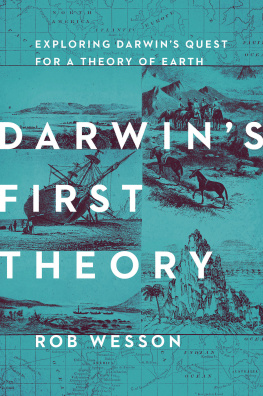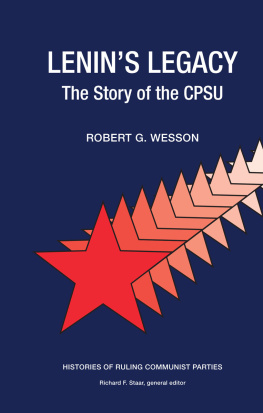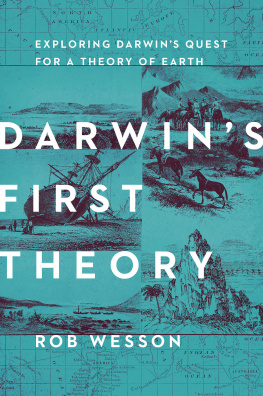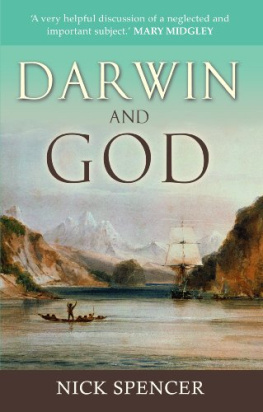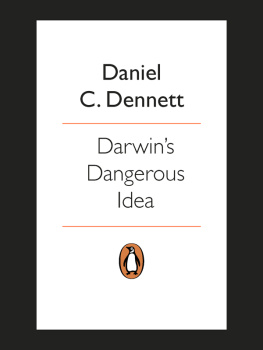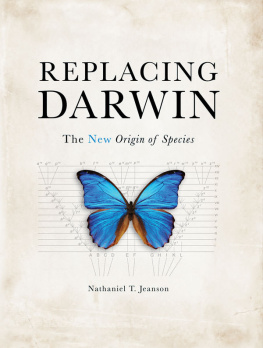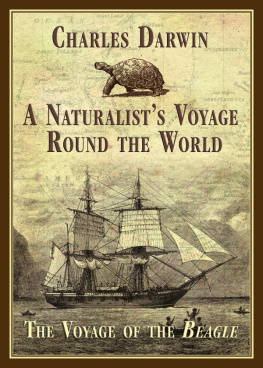

DARWINS FIRST THEORY
Pegasus Books Ltd.
148 W 37th Street, 13th Floor
New York, NY 10018
Copyright 2017 by Robert L. Wesson
First Pegasus Books edition April 2017
Maps copyright 2017 by Jeffrey Ward
Interior design by Maria Fernandez
All rights reserved. No part of this book may be reproduced in whole or in part without written permission from the publisher, except by reviewers who may quote brief excerpts in connection with a review in a newspaper, magazine, or electronic publication; nor may any part of this book be reproduced, stored in a retrieval system, or transmitted in any form or by any means electronic, mechanical, photocopying, recording, or other, without written permission from the publisher.
Library of Congress Cataloging-in-Publication Data is available.
ISBN: 978-1-68177-316-2
ISBN: 978-1-68177-377-3 (e-book)
Distributed by W. W. Norton & Company
For all those who have suffered
from the paroxysms of Planet Earth...
And for those curious ones who render
its behavior ever less mysterious.
CONTENTS
ILLUSTRATIONS LIST
DRAWINGS
MAPS
I n the nearly two centuries since the voyage of the HMS Beagle , styles, spelling, and conventions in both English and Spanish, as well as geographic names, have changed, leading to consequences ranging from quaint amusement to downright confusion.
In the quotations from letters, journals, articles, and books from the period, I have tried to maintain the original spelling and punctuation. Spelling was not as standardized then as it is now, and Darwin himself was not a particularly good speller. His confusion with compass directions offers a hint of dyslexia. The punctuation and construction in his notes and letters reflect the style of the times, but are also to some extent idiosyncratic. Among Darwins correspondents, Charles Douglas, an Englishman, residing on the Chilean island of Chile, may be the worst speller ever to allude to Miltons Paradise Lost , although Douglas likely didnt have the opportunity for an education to match his native intelligence. To capture the spirit and tenor of the times I have tried to preserve these mannerisms, quirks, and foibleswarts and allonly interfering when the meaning is obscured.
Geographic names and their spellings present another set of problems. The country that we now know as Chile, was sometimes referred to as Chili. The city in Chile and the island in the Cape Verde Islands, both now known universally as Santiago, were referred to in English as St. Jago. In 1834, shortly after the departure of the Beagle , the name of the city on Chile Island, previously known as San Carlos de Chile, was formally changed to Ancud. The standardization of the spelling of some geographic names derived from Mapudungun and its relatives, the languages spoken by the native peoples of south-central Chile and Argentina, remains a work in progress. The translation of the sounds hua and hui are particular problems. What was called Huafo Island by Robert FitzRoy and Darwin, is now Guafo Island. Huamblin Island is now Guamblin Island. Darwin and FitzRoy also used English names for several places for which Spanish names are commonly used today. In quotations and where the meaning is clear, I have used the names in the original sources. Where confusion might arise, I have used the modern name.
In the U.K., Welsh and Scottish place names present their own special charm to those of us speakers of English who have not grown up with them. For mea product of the State of WashingtonSeattle and Suiattle, Snohomish and Skykomish, all roll off my tongue, but Betws-y-Coed catches me up short.
Another possible source of confusion is that there are several rivers named Ro Negro in South America. The two that I mention herein, are first, the most important river of Uruguay, and the second, a river farther south in Argentina, in northern Patagonia.
I have tried to provide a path for the reader through this linguistic and nomenclatural obstacle course that is, at the same time, true to the original, yet also intelligible to the modern reader, especially to one who is familiar with the modern names or who may wish to consult a map or atlas. I beg the readers forgiveness for any shortcomings or lapses that may remain.
Last but not least, and as unlikely as it might seem, the two men that I met at the potato field in Lipimvida, Chileone the owner, the other the overseer and laborer who was caught in the tsunami of 2010as well as a school administrator in Tira were all named Don Jos Luis. To avoid confusion, and with apologies to both, I refer to two of these gentlemen by their last names, the land owner in Lipimvida as Seor Ruz, and the school administrator in Tira as Seor Montero.
H is eyes told the story. Dark eyes, rimmed with red. Sad, weary, haunted eyes. They didnt tell the whole story, not by a long shot. But one persons story, his story.
Behind us across the dunes I could hear the muffled crash of breakers on the beach. We stood in the jumble of his yard, strewn with scattered piles of boards and odd bits of furniture. Don Jos Luis, a slender, lanky man with a slight stoop, wore a broad, flat-brimmed straw hat. It shaded those eyes from the sun. He was not so much old as worn. His slow gait, his roughened hands, his deeply lined face patched with gray stubble, spoke of work in the potato field a hundred yards down the road. A man of the countryside, Marco later said. His small, pink one-story house lay before us, twisted off its foundation, reminiscent of Auntie Ems house from The Wizard of Oz , windows boarded, one wall patched with fiberboard. But the eyes of Don Jos Luismournful, downcast, remembering eyesthose eyes told his story of the tsunami.
Marco pulled out his notebook and began the interview. Don Jos Luis spoke quietly and slowly, answering Marcos questions. I looked on, struggling to follow the colloquial Chilean Spanish. Marco read his notes aloud as he wrote, checking them with Don Jos Luis for accuracy. On the night of February 27, 2010, Jos Luis Daz Faras was sleeping in his house located only a few yards from the sea. Between three and four in the morning the ground began to shake. It was a large earthquake that lasted about two minutes. It moved the whole house, making it jump, he said. After the shaking stopped, he checked on his neighbor next door. Then he and his sister, Mercedes, began to prepare some coffee to calm their nerves.
Why didnt you go up the hill when you first felt the earthquake? Marco asked. This after all is the first tenet of tsunami education and understanding tsunamis. Helping the people of Chile to prepare for them is Marcos passion.
Nobody told us, Don Jos Luis said. Nobody told them. Marco and I shook our heads later as we repeated his words.
As they fixed the coffee, suddenly, through the window his sister saw the sea was rising.
I was surprised to see her move so fast, he said. He tried to follow her, as she ran across the road toward the hill, but his legs would not move as quickly. He couldnt keep up. The first wave of the tsunami caught him as he was crossing the road, the water rising to his knees. Then the water began to recede, tugging at his legs, dragging him out to sea. He grabbed the branches of a large bush and held on. Held on for dear life.
Finally escaping the grip of the receding water he made his way up the hill, joining his sister. Together, they watched the second wave approach, seeing it clearly thanks to the full moon. This wave rose much higher than the first, already carrying debris. A horrific din rumbled through the night, the roar of breaking wood and glass, as the wave crushed and shattered the houses along the road.
Next page
